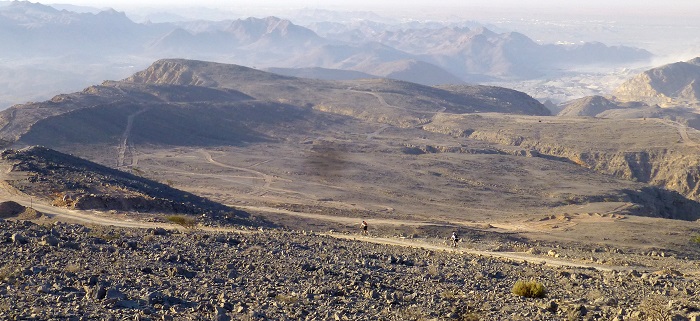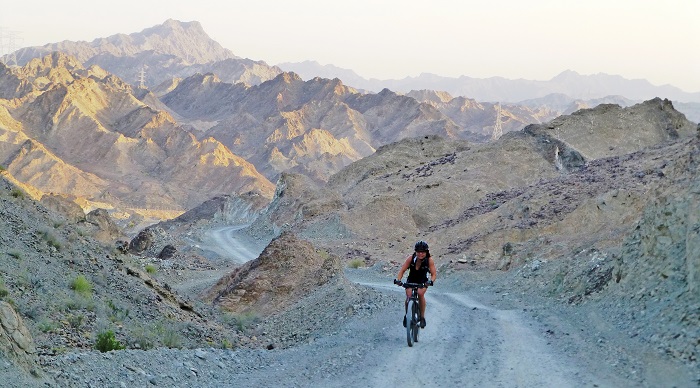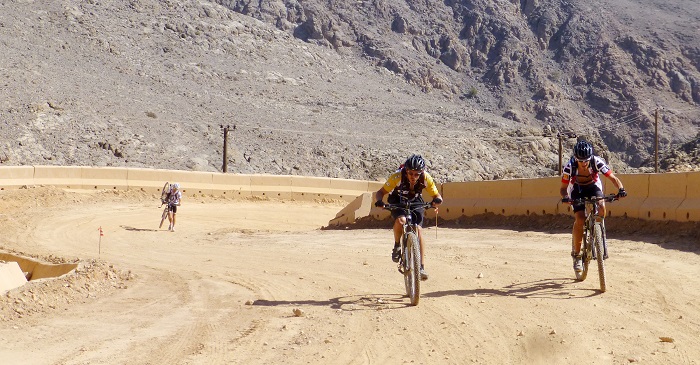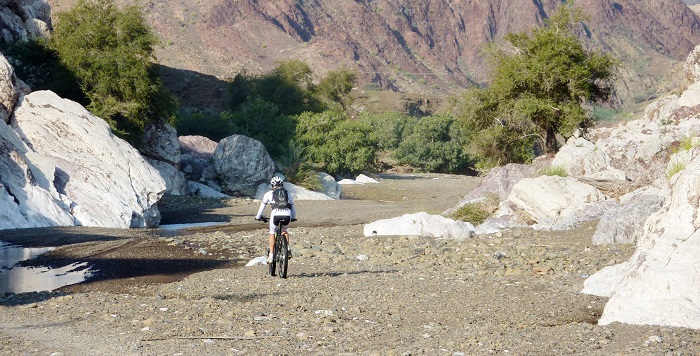In this series of articles looking at how you can get stronger on your mountain bike we take a peek at different zones; heart rate or training zones to be precise. In this series we look at core strengthening and major muscle exercises for you to follow.
Roadies will tell you how much their lives have changed after spending 6000 AED on a power metre and following strictly, religious routines when they go out riding. Have you ever asked a rider who has a power metre attached to their bike if they want to go for a ride? Before they commit to hitting the trails with you, they need to know how long the ride is, how much ascent, how fast and then they need to go and check if it’s ok with their coach. They might have a big race in a couple of months and don’t want to overdo it.
On the whole mountain bikers are a bit more relaxed and just tend to go out and ride. Sometimes the ride takes a bit longer and you come back smashed. Sometimes it’s a bit shorter and you manage to get back in before midday and the sun toasts you because you have an important brunch back in Dubai. If you go out mountain biking with someone stronger, you try to keep up. If you’re in a big group of mixed ability in the mountains and on the trails, you might end up taking a lot of pictures or chatting a bit more.
However there are advantages to using a systematic approach and it is important to understand the basics of fitness and how to improve it. Power metres are great and provide benefits, but for the general mountain bike rider the technology is not completely there yet. So this month we shed some light on how to adapt an approach into your off-road riding that is considered a bit old school and a bit out of date.
Heart Rate Zones VS Power Metres
Using heart rate zones to improve your mountain biking is possible and although on the whole superseded by power metre training, it can still be relevant, cheaper and a less fussy. Power metres are notoriously difficult to get for mountain bikes. Once you have one, you have to keep it correctly calibrated and protected against the constant knocking and bumping on a mountain bike. You also have to understand the key to improvement is analyzing and collecting the vast amount of data they produce. Power metres are available for mountain bikes but if you can’t afford one, understanding the subject matter below will also help you become a better rider. So this is not an article about whether heart rate or power metres are best for mountain biking but rather to offer a simple training plan for those who are interested in discovering a bit more about how to improve on their mountain bikes
Key terms

Maximum Heart Rate
All the zones that you will exercise in are based on your maximum heart rate. Once you have calculated your own, everything else will fall into place. Maximum heart rate can be effected by many things, such as sickness, the weather etc. which is why power metres have become more popular and reliable. Producing around 350 watts of power is the same on any day of the week.
To measure your Resting Heart Rate
Take your heart rate first thing in the morning lying in bed before you get up. You can do this either with an electronic device and chest strap or manually with your fingers. Do this every day for a week and record it. It’s important to ensure that you’re well rested and not ill or under any stress when recording. At the end of the week you can calculate your resting HR average. As you get fitter it should drop.
To measure your Maximum Heart Rate
Many people calculate their maximum HR by using the formula of 220 minus their age. It can be close but not completely accurate and is really too general. For example all 44 year olds will not have the same max HR. So to be as accurate as possible, there is a physiological test that you can do yourself. You should be reasonably fit and capable before doing this test. It is ok to do this test on a section of road rather than a dirt trail.

Warm up thoroughly for at least 15 minutes. On a long, steady hill, like the start of the Roadsters Hatta ride. Start off fairly briskly and increase your effort every minute. Stay seated and keep increasing the speed until you can’t go any faster. At this point get out of the saddle and sprint as hard as you can for 15 seconds. At the end of the 15 seconds you will have your max HR. If your electronic device has recorded it automatically that’s great, if not do a manual check immediately.
A point to note is that your max HR on a bike will be much lower than it is when you’re running because the bike is taking some of your weight. Also it is worth rechecking your max HR every few months to see any differences.
The Zones
So now that you have your max HR, all the training zones can be calculated automatically. Get out to your calculator (or search the internet)
Zone One (60-65% of Max HR): For long, easy rides, to improve the combustion and storage of fats.
Zone Two (65-75% of Max HR): The basic base training zone. Longer rides of medium stress.
Zone Three (75-82% of Max HR): For development of aerobic capacity and endurance with moderate volume at very controlled intensity.
Zone Four (82-89% of Max HR): For simulating pace when tapering for a race.
Zone Five (89-94% of Max HR): For raising anaerobic threshold. Good sessions for 10 and 25-mile time-trials.
Zone Six (94-100% of Max HR): For high-intensity interval training to increase maximum power and speed
How to use these zones
Now you know what zones are unique to you, you can go about planning a personal schedule. To be rigorous and stick to an individual plan requires complete discipline which is where you see riders constantly watching their data. If you do, you will probably see very fast results but most of your riding will be alone.
When you do a mountain bike ride it’s important to look at the overall results from that ride as well as the detail. Many websites will allow you to upload the data if you have recorded it. From this you can see not only what your average heart rate was but also any peaks and troughs.
For example if you intend to do a two hour ride in Zone Two and want to keep the average heart rate the same throughout, you need to find a trail without any hills or steep sections that might produce spikes or dips.

Some simple training sessions
These are examples of typical sessions that you could follow on your mountain bike. You will need to have calculated your max HR and then the relevant percent.
Fat burning slow and easy
One of the benefits of mountain biking is that your body shape will change and your body fat percentage will drop naturally. You can encourage quicker results by staying in the zone that optimizes fat burning. Surprisingly it is fairly low and you must stick to it.
Three hours at Zone Two
Fat burning fast and hard
HIIT or high intensity interval training has become very popular recently as it can be done in a short period of time and because it hurts, it feels like you are progressing.
These sessions will build fast twitch muscles, speed and burn incredible amounts of body fat during and after. A typical session will take less than an hour.
15 minute warm up
4-6 max effort sprints (Zone Six) of 30 seconds with a 4 -5 minute recovery between each sprint
10 minute warm down
Build endurance
In mountain biking, endurance is the ability to keep going. Normally, any ride that is over two hours and where you need to eat could be considered as requiring endurance. You may have heard people talk about LSD or long steady distance.
To build your endurance it is good to do two endurance sessions a week if you have time such as these below.
3-4 hours at Zone Two
2 hours at Zone Three
If you get bored riding for three to four hours at the same heart rate, you could give a 10 minute burst at Zones Three to Four every hour.
Recovery ride
A recovery ride is really what is says. Nearly everyone overtrains and can suffer plateaus in performance and injuries. Keep in mind to make your hard days very hard and the easy days very easy. Using this principle, make sure you have at least one rest day per week and another day that is a really slow recovery ride.
1 hour at Zone 1
Don’t forget that most importantly you should enjoy your mountain biking. Mix the different types of sessions above to give you variety and see which ones you like the most. There are many different approaches and training plans. Keep trying and changing. The 80/20 is a simple one. 80% of your riding should be easy (around 77% of max HR) and 20% at high intensities. Maybe you will discover hidden talents within your mountain biking. If it’s all too confusing, nearly everyone has an opinion on different training methodology. Talk to friends, read internet discussion forums and seek out advice from an expert you trust or is qualified. The more you talk about it, the more you will understand and be able to make your own decisions and be a stronger rider.

Words By: Sean James

